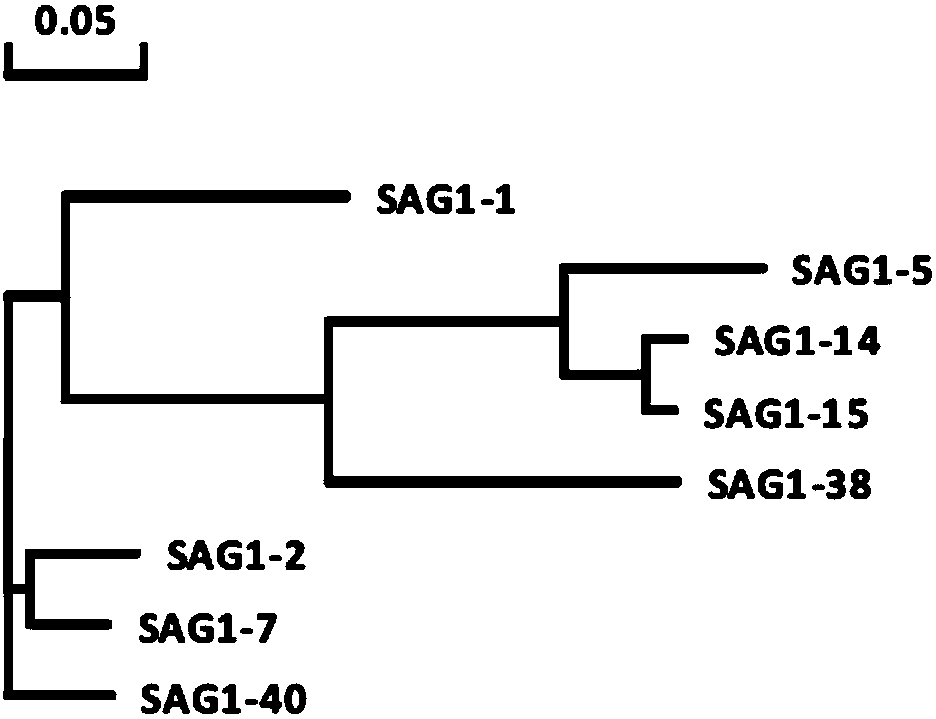Nano antibody for resisting toxoplasma gondii SAG1 as well as coding gene and application thereof
A nano-antibody and Toxoplasma gondii technology, applied in application, genetic engineering, plant genetic improvement, etc., can solve the problems of low detection rate and unsatisfactory demand, and achieve high affinity, excellent tissue penetration ability, and high water solubility sexual effect
- Summary
- Abstract
- Description
- Claims
- Application Information
AI Technical Summary
Problems solved by technology
Method used
Image
Examples
Embodiment 1
[0023] Recombinant SAG1 protein, the steps are as follows:
[0024] (1) Toxoplasma gondii cDNA was extracted by Trizol method, and PCR amplification primers were designed according to the Toxoplasma gondii SAG1 gene sequence on NCBI (GenBank number: HM776940.1);
[0025] (2) PCR amplification to obtain the SAG1 target gene fragment with a fragment size of 780bp, and construct the SAG1-pET28a recombinant vector;
[0026] (3) The SAG1-pET28a recombinant vector was transformed into competent cells BL21 by heat shock method, induced by IPTG at 37°C, expressed the recombinant protein, collected the bacteria, after ultrasonic disruption, purified by Ni-NTA nickel strain, and verified the recombinant SAG1 protein by SDS-PAGE get the expression ( figure 1 ).
Embodiment 2
[0028] To construct the Toxoplasma gondii-specific nanobody library, the steps are as follows:
[0029] (1) Purify the recombinant SAG1 protein (surface membrane antigen) of Toxoplasma gondii, then mix 1 mg with Freund's adjuvant in an equal volume, and immunize a camel (Camelus bactrianus). The experiment was carried out in Chifeng, Inner Mongolia, in 2015 May), once a week, a total of 4 times of immunization, to stimulate B cells to express antigen-specific nanobodies;
[0030] (2) After the 4 times of immunization, extract 100ml camel peripheral blood lymphocytes and extract total RNA;
[0031] (3) Synthesize cDNA by reverse transcription and use nested PCR (Nest PCR) to amplify the heavy chain variable region gene VHH;
[0032] (4) Use restriction endonucleases to perform double enzyme digestion on the amplified product of Nest PCR and the phagemid carrier pHEN 4, and purify the digested product according to the molar ratio of the optimized VHH insert fragment to the carr...
Embodiment 3
[0037] Panning of specific Nanobodies. Proceed as follows:
[0038] (1) Dissolve in 100mM NaHCO 3 , 30 μg recombinant SAG1 protein of Toxoplasma gondii at pH 8.2 was coated on NUNC microtiter plates, and placed overnight at 4°C;
[0039] (2) Add 100 μl of milk with a mass concentration of 3% the next day, and block at room temperature for 2 hours;
[0040] (3) After 2h, add 100μl 2×10 11 pfu contains the helper phage of the above-mentioned nanobody library, and acts at room temperature for 1 hour;
[0041] (4) Wash 10 times with 0.05% PBS+Tween-20 for the first round of panning / 20-25 times for the second round to remove non-specifically bound phages;
[0042] (5) Use 100mM TEA (triethylamine) to dissociate the phage that specifically binds to the recombinant SAG1 protein of Toxoplasma gondii, and infect Escherichia coli TG1 in logarithmic growth phase, culture at 37°C for 1 hour, produce and purify the phage for the next round The panning was gradually enriched, and the res...
PUM
 Login to View More
Login to View More Abstract
Description
Claims
Application Information
 Login to View More
Login to View More - R&D
- Intellectual Property
- Life Sciences
- Materials
- Tech Scout
- Unparalleled Data Quality
- Higher Quality Content
- 60% Fewer Hallucinations
Browse by: Latest US Patents, China's latest patents, Technical Efficacy Thesaurus, Application Domain, Technology Topic, Popular Technical Reports.
© 2025 PatSnap. All rights reserved.Legal|Privacy policy|Modern Slavery Act Transparency Statement|Sitemap|About US| Contact US: help@patsnap.com



